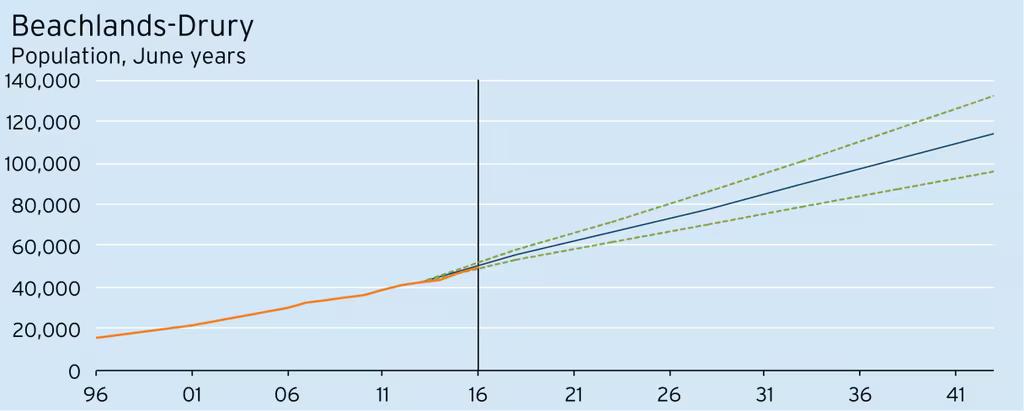Auckland: Beachlands-Drury
This article is part of the Regional Hotspots report.
Highlights
- Population growth 2013-2023: 54% (24,590 people)
- The Beachlands-Drury area has room for 12,000 new dwellings across 11 Special Housing Areas with 90% of these in Flat Bush, Hingaia and Takanini.
- Large population growth is expected in Flat Bush between now and 2021 will be supported by social, retail and commercial development in and around the town centre.
- Hingaia will grow on the back of planned residential developments, the areas access to the motorway, and expansion of schools. This will place increased demand on the Papakura Town Centre.
- New recreational and community facilities make Takanini attractive to live, and it is well placed to cope with additional growth.
- Beachlands and Maraeetai urban coastal appeal is likely to be capitalised on by developers over the next few years.
- Ongoing infrastructure investment will be required in many of the areas in and around Beachlands-Drury to keep up with population growth.
The most difficult part about including part of south Auckland as a hotspot is that almost the entire southern and eastern third of the city could be highlighted in our report. Between the mix of infill housing, increasing densification around suburban hubs, major new areas of development including some large Special Housing Areas, and general expansion around the urban fringes, south Auckland encapsulates the growth pressures that the Auckland region is grappling with as its population continues to grow.
We have chosen to focus on a relatively large swathe of land stretching from Beachlands and Maraetai in the northeast around to Papakura and Drury in the south. The breadth of this area reflects the enormous stresses that are currently being felt in Auckland’s housing market and the ubiquity of urban development that is necessary across the region.
In terms of the hotspots that we have selected across the Auckland region, Beachlands-Drury has the greatest potential number of new dwellings in Special Housing Areas, with room for over 12,000 new dwellings across 11 SHAs. The bulk of these new dwellings, at about 10,000, will be located in three large SHAs: the Flat Bush Strategic Area, Hingaia, and the Takanini Strategic Area.
Estimates of the population across the Beachlands-Drury area up to June 2016 suggest that population growth is running below Statistics NZ’s medium projections. However, as activity picks up across the SHAs and residential construction work in Auckland continues to increase in response to strong demand pressures, we expect to see a considerable increase in the number of people living in the Beachlands-Drury area.
Flat Bush
Flat Bush borders on the Ormiston and Dongegal Park areas that have already undergone significant residential and other development. Auckland Council has put significant planning resources into Flat Bush to ensure an attractive and well-ordered town centre is developed, and the Council owns about 90% of the land that will be used in the town centre. A supermarket and primary school opened in 2015, while Barry Curtis Park provides a large green space with a range of community and recreational facilities. A library and aquatic centre are also planned, and Ormiston Junior High School (catering for years 7-10) will open at the start of 2017. Considerable population growth will also be supported by retail and commercial development in the town centre between now and 2021, along with ongoing investment in the expansion and upgrades of civil infrastructure such as roading, water, and wastewater networks.
As is planned with zoning changes around a number of existing suburban centres across Auckland, Flat Bush is planned to have a cluster of higher-density apartments and townhouses around the town centre, complemented by standalone houses in the surrounding areas, resulting in almost 4,500 new dwellings in total.
Hingaia
There is currently very little housing on the Hingaia Peninsula to the west of Auckland’s Southern Motorway. A number of developers currently have plans for the residential development of this land that has previously been used for rural purposes, with room for almost 3,500 dwellings in the SHA.
The government has invested in the upgrade and expansion of existing schools in the area as well as announcing funding for a new primary school. The area also already has relatively good access to the motorway via the Papakura interchange. However, unlike the development at Flat Bush, plans for new retail or community facilities are relatively limited. Land along either side of Harbourside Drive has been zoned for mixed use and is likely to result to be mostly used for retail development. But the expanding population is also set to boost demand at the Papakura Town Centre, and could contribute to continued revitalisation and expansion of the services available in the town.
Takanini
The final major SHA within the Beachlands-Drury area is the Takanini Strategic Area. With provision for almost 2,100 additional dwellings this SHA builds on the development that has already taken place over recent years, highlighted by the construction of Bruce Pulman Park with its substantial recreational and community facilities, alongside the big-box retailers at Southgate and other retail facilities at Takanini Village. In this regard, Takaknini is probably already well placed to cope with further significant population growth.
Given the current rural-urban boundary, there is room for further development occur northwards towards Alfriston. Notwithstanding the location of Ardmore Airport, flat land stretching further to the east also shapes as a potential location for additional development over the longer-term, as it would potentially provide better access to existing transport routes and other infrastructure than expansion out past Karaka on the southern side of Manukau Harbour.
Beachlands and Maraetai
nevertheless represent an area of solid projected population growth over the next decade and beyond. The nature of this growth will be somewhat different to much of the rest of the housing development across south Auckland, which is largely focused on trying to accommodate some of the city’s rapidly expanding population in a reasonably timely and cost-effective manner. Being on the outskirts of the urban area, Beachlands and Maraetai have maintained some of their historic holiday feel. That slightly less urban coastal appeal is set to be further capitalised on by developers over coming years, with apartment projects in the works and plenty of residential subdivision planned as well.
Although the drive into Auckland’s CBD is relatively long, the ferry service from Pine Harbour means that the commute can still be a relatively comfortable one. Furthermore, with the expanding industrial sector presence in East Tamaki and burgeoning population around the eastern fringes of Auckland, Beachlands and Maraetai are well located for employment opportunities in these areas.
The construction of a supermarket along with supporting retail and office facilities in Beachlands will also boost the amenities available in the area, increasing its attractiveness for people to live and enabling further population growth over the medium term.
"Beachlands and Mareaetai urban costal appeal is likely to be capitalised on by developers over the next few years."














